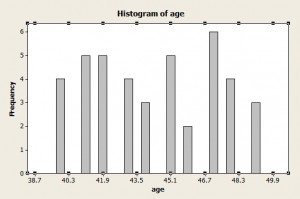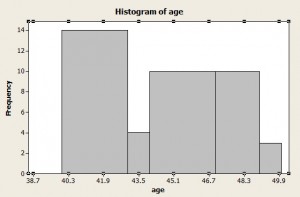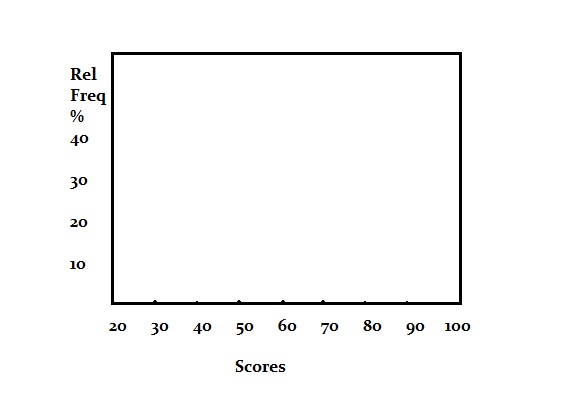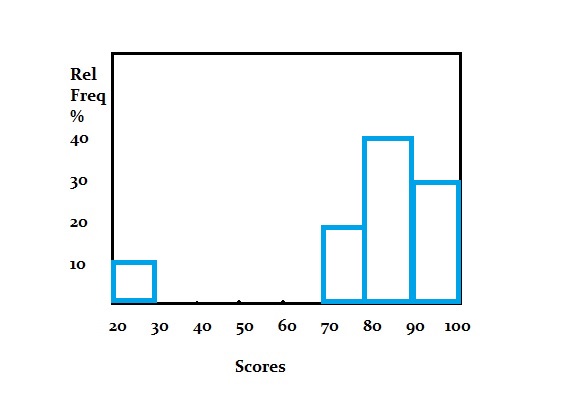Read the Directions for Creating a Histogram
Contents:
- What is a Histogram?
- What is a Bihistogram?
- Make a Histogram:
- By Hand
- Minitab
- SPSS
- TI-83
- TI-89
Meet also: Excel Histogram
Sentinel the video to see how to make a histogram by manus:
Can't see the video? Click here.
What is a Histogram?
Histograms are similar to bar charts; they are a way to display counts of data. A bar graph charts actual counts against categories; The height of the bar indicates the number of items in that category. A histogram displays the same categorical variables in "bins".
A bin shows how many data points are within a range (an interval). Ordinarily, you choose the range that all-time fits your data. There are no gear up rules about how many bins you tin accept, but the rule of thumb is five-xx bins. Any more than than 20 bins and your graph will be hard to read. Fewer than v bins and your graph will take footling (if whatsoever) meaning. About graphs you'll create in unproblematic statistics will have most 5 to 7 bins.

Graph with 5 bins

Too many bins.
Some other dominion of thumb for bins is that if a value falls into two bins, place it in the upper bin. For example, if you are making a histogram of ages and your bins include 40-42 and 42-44, a participant who is 42 years one-time should be placed in the 42-44 bin.
What does the height of a bar in a histogram represent?
Dissimilar a bar nautical chart, the area of a bar in a histogram represents the frequency, not the height. The frequency is calculated past multiplying the width of the bin by the pinnacle. The summit of a bar in a histogram indicates frequency (counts) only if the bin widths are evenly spaced. For example, if you are plotting magnitudes of earthquakes and your bins are 3-5, 5-vii and 7-9, each bin is spaced two numbers apart and so the acme of the bar would equal the frequency. However, histograms don't always have even bins. When a histogram has uneven bins, the height does non equal the frequency.

Histogram with uneven bins (the height does Not indicate frequency).
Dorsum to Meridian
The Bihistogram
A bihistogram is a graph made from two histograms ("bi" = two) in opposite directions. 1 histogram is above the axis and one is beneath it. The histograms can exist back-to-dorsum on opposite sides of either the y-axis or the x-axis. Each half represents a different category.
The bihistogram is a visual alternative to an contained samples t-examination. It tin exist more useful than the t-test because many features are visible on the same plot, including:
- Skewness.
- Location (Where on the horizontal axis the graph is centered).
- Scale (if the graph is stretched or squeezed. See: scale parameter.)
- Outliers.
Creating a Bihistogram
The bihistogram is rarely used compared to other statistical techniques, and so most popular software doesn't have the capability of creating one. Two programs that do have options are R and Dataplot. SPSS Likewise provides a means to lay histograms side by side, which effectively gives yous a the same affair.
Bihistogram in R
There doesn't seem to exist a unproblematic office in R for creating bihistograms, but StrictlyStat suggests overlaying two histograms on tiptop of each other, for the same effect. For the code using either ggplot or base graphics, see this commodity the R-Bloggers site. You can also observe an online calculator (that uses an R module) here at Wessa.cyberspace. I did attempt out the online calculator; be patient, as information technology tin can take several minutes for the graph to appear.
Dataplot
The command in Dataplot is BIHISTOGRAM
Make a histogram: Overview
A histogram is a way of graphing groups of numbers according to how often they appear. This article will show you how to make i past hand, but you're much amend off using technology, like making an Excel histogram. Choosing bins in statistics is commonly a matter of an educated judge. When you lot make a histogram past hand, y'all're stuck with your original bin settings. With Excel (or other software), you can change the bins later on you've created the histogram, giving y'all the power to play around with bin sizes until you have a chart you're happy with. OK, plenty of lecturing almost technology. Sometimes you might accept to make a histogram past manus, especially if you're making a relative frequency histogram; Technology like TI-83s will only create regular frequency histograms. If you have to create a histogram by hand, here's the easy way.
Brand a Histogram: Steps
Sample question: Create a histogram for the post-obit examination scores: 99, 97, 94, 88, 84, 81, eighty, 77, 71, 25.
Step 1: Describe and characterization your x and y axis. For this instance, the ten-axis would be labeled "score" and the y-axis would exist labeled "relative frequency %."
Step 2: Cull the number of bins (how to cull bin sizes in statistics) and label your graph. For this sample, question, groups of x (the x-axis values are the bins) are a practiced choice (it looks like you'll take five bars of one or two items in the grouping).
Step three: Divide 100 by the number of data points to get an idea of where to place your frequency "ticks". We take 10 items in our data set, and then it makes sense to count by 100/10 = 10% (one particular would equal 10% of the total).

Step iv: Count how many items are in each bin then sketch a rectangle on the graph that corresponds to the percentage of the total that bin fills. In this sample information set up, the showtime bin (20-30) has one item, seventy-80 has two items. If an particular falls on a bin boundary (i.eastward. fourscore), identify it in the next bin upwards (80 would go in 80-xc).

That's it!
Tips
Tip i: If you lot're unsure about how many bins to choose, consider making a rough chart online with this Shodor.org tool. Play effectually with the bins (change the interval size) until you become a nautical chart that you like the await of.
Tip 2: Choosing where to identify the frequency ticks is as well somewhat of a judgment call and is rarely an exact science. For case, if yous had 21 items, you could place your ticks at 5% although each item would exist slightly less than v%. Comport that in mind when you sketch the graph.
Alarm: Choosing optimal bin sizes gets very complex with big data sets (run into this article for an example of the ugly math). The larger your data gear up, the better off yous are using engineering science.
Dorsum to Pinnacle
How to make a histogram in Minitab
Minitab is software package that is similar to Excel or other spreadsheet programs.
Scout this short video on how to make a histogram in Minitab:
Can't see the video? Click here.
How to brand a histogram in Minitab: Steps
Step 1: Blazon your data into columns in Minitab. In nigh histogram cases, you'll take two sets of variables in two columns.
Step 2: Click "Graph" and and then click "Histogram."
Step iii: Choose the type of histogram you lot desire to make. In most cases for elementary statistics, a "Simple" histogram is usually the best option.
Step iv: Click "OK."
Step 5: Choose the name of the variable you want to make a histogram for and and so click the "Select" button to motion that variable proper noun to the Graph Variables box.
Step vi: Click "OK" to create the histogram in Minitab.
Step 7: (Optional)Alter the number of bins (category widths) by clicking on i of the bin headings (numbers) at the base of a bar. This opens the Edit Calibration box. Click "Binning" and so click the "Number of intervals" radio push button. Modify the number of bins and click "OK."
Tip: When you type your data into Minitab, brand sure to give your variables meaningful names in the kickoff row (the column header). This makes it easier to cull the variable you want to plot in Step 5.
Histogram on the TI-83: Overview
Let's say you have a listing of the heights of New York Urban center's tallest buildings. Here'southward how to put it into the TI 83 and plow it into a histogram in a jiffy.
Sentry the video for the steps:
Can't see the video? Click here.
Histogram TI-83: Steps
Example problem: Make a histogram depicting the tiptop 20 tallest buildings in New York City. The heights of the top 20 buildings (in anxiety) are: 1250, 1200, 1046, 1046, 952, 927, 915, 861, 850, 814, 813, 809, 808, 806, 792, 778, 757, 755, 752, and 750.
Step one: Enter the data into a list. Press the STAT button and so press ENTER for the "Edit" option. Enter the kickoff number (1250), and then press ENTER. Continue entering numbers, pressing the ENTER button later each entry.
Step 2: Press "2nd," then "Y=" to choose "Stat Plot."
Step 3: ENTER to cull plot "ane."
Step 4: Press ENTER again. This selects "On."
Footstep 5: Hit the down pointer fundamental (the pointer keys are at the meridian right), and then press the right arrow key twice. Your cursor should be flashing over the histogram option, which is the top right selection in the list.
Step 6: Arrow down to XList and enter the proper name of the list you entered your data in Step 1. If this is your first time building a list, you most likely entered the data in "L1," which is the default listing. If "L1" is not showing, press "2d" and then "1" to choose "L1."
Step 7: Pointer downward and and then type "ane" for "Freq."
Step 8: Press the "graph" button. This volition bring upwardly a graph of the histogram on your screen. Press "Zoom" and then "Zoomstat" to view the histogram.
Tips
Tip #one: Press the TRACE push button, and pointer back and forth from left to right. This will display the number of items in each category (n=), as well as the upper and lower form limits.
Tip # ii: To change the form width, press WINDOW and change the Xscl. For example, if y'all want a class width of 100 (probably the nigh suitable for the above data), alter "Xscl" to "100."
That's how to create a Histogram on the TI-83!
Example 2
Draw a histogram for the post-obit contempo examination scores in a statistics class: 45, 67, 68, 69, 74, 76, 75, 77, 79, 84, 86, 90.
Step 1: Printing STAT, then ENTER to edit L1.
Step 2: Enter the data from the trouble into the list. Printing ENTER after each entry. For example, for the first ii entries you would blazon:
4 five ENTER
six 7 ENTER
Step 3: Press 2nd and then Y= to access the Stat Plot carte du jour.
Step 4: Press ENTER twice to plough on Plot1.
Footstep 5: Arrow downward to Type, which has 6 icons to the right of it. Highlight the top right icon, which looks like a histogram, and printing ENTER to select it.
Footstep 6: Make sure the XList entry reads "Lone". If it doesn't, arrow down to it, Press Articulate, then 2nd, 1.
Pace 7: Printing Graph. Y'all should see your Histogram.
Tips
Tip: If when you press Graph, you see the bulletin "Err: Stat", or you merely don't meet a histogram like you wait to, and then Press "Window," and try different settings. Particularly effort changing the Xscl (X Calibration) item to a larger value.
That'south it!
Dorsum to Pinnacle
TI 89 Histogram
Once y'all take input the data for the TI 89 histogram and graphed it, the TI-89 will even count how many items are in each bar (or grade).
TI 89 Histogram: Steps
Watch the video for the steps:
Can't see the video? Click here.
Instance trouble: Create a histogram for the following new car costs: 12,500; 22,400; 14,300; 32,200; 21,500; 19,980; xv,001; 22,001; 32,036; 35,124; 29,001; 25,006; 27,001; and 18,500.
Pace 1: Press APPS and ringlet to the Stats/List Editor. Press ENTER.
Pace 2: Press F1 then 8 to clear the listing editor of data.
Step three: Enter "cars" as the list proper name by pressing 2d Alpha )=23 ENTER.
Footstep 4: Enter your data:
12500 ENTER
22400 ENTER
14300 ENTER
32200 ENTER
21500 ENTER
19980 ENTER
15001 ENTER
22001 ENTER
32036 ENTER
35124 ENTER
29001 ENTER
25006 ENTER
27001 ENTER
18500 ENTER
Stride v: Press F2 ENTER and F1 to become into Plot Setup (Define Plot).
Step 6: Press the right roll pointer to bring up a carte du jour for Plot Type. Press 4 for Histogram.
Step 7: Roll down to "x" Press 2d – (the minus key) to bring up Var-Link. Scroll down to "cars" and press ENTER.
Step 8: Scroll down to Hist. Saucepan Width and enter 5000 ENTER. This is your class width.
Pace 9: Press ENTER F5. Note: If you lot printing ENTER too many times and end up at the domicile screen, just press the diamond key and then F3 (for graph).
Stride 10: Press iii for the trace part. Utilise the left and right scroll keys to move from one bar to another. (This volition tell you how many items are in each grade (n = x)).
Tips
Tip #1: If your TI 89 histogram doesn't show (or but part of the graph shows), you lot may need to modify the window. Press the diamond primal then F2 to check your window settings. For the above graph, your settings should be approximately 10000 < x < 40000 and 0 < y < 8. Set the xscl and yscl to one. Printing F2 and so nine to render to the graph.
Tip #2: Make sure the blastoff lock is turned on by checking for a footling black box with "a" in information technology on the bottom left of your screen.
Back to Top
References
Beyer, Westward. H. CRC Standard Mathematical Tables, 31st ed. Boca Raton, FL: CRC Printing, pp. 536 and 571, 2002.
Gonick, 50. (1993). The Cartoon Guide to Statistics. HarperPerennial.
Klein, G. (2013). The Cartoon Introduction to Statistics. Hill & Wamg.
Vogt, W.P. (2005). Dictionary of Statistics & Methodology: A Nontechnical Guide for the Social Sciences. SAGE.
---------------------------------------------------------------------------
Need help with a homework or test question? With Chegg Study, you tin can get pace-past-pace solutions to your questions from an expert in the field. Your outset 30 minutes with a Chegg tutor is gratuitous!
Comments? Need to post a correction? Please mail a comment on our Facebook page .
Source: https://www.statisticshowto.com/probability-and-statistics/descriptive-statistics/histogram-make-chart/
0 Response to "Read the Directions for Creating a Histogram"
Post a Comment